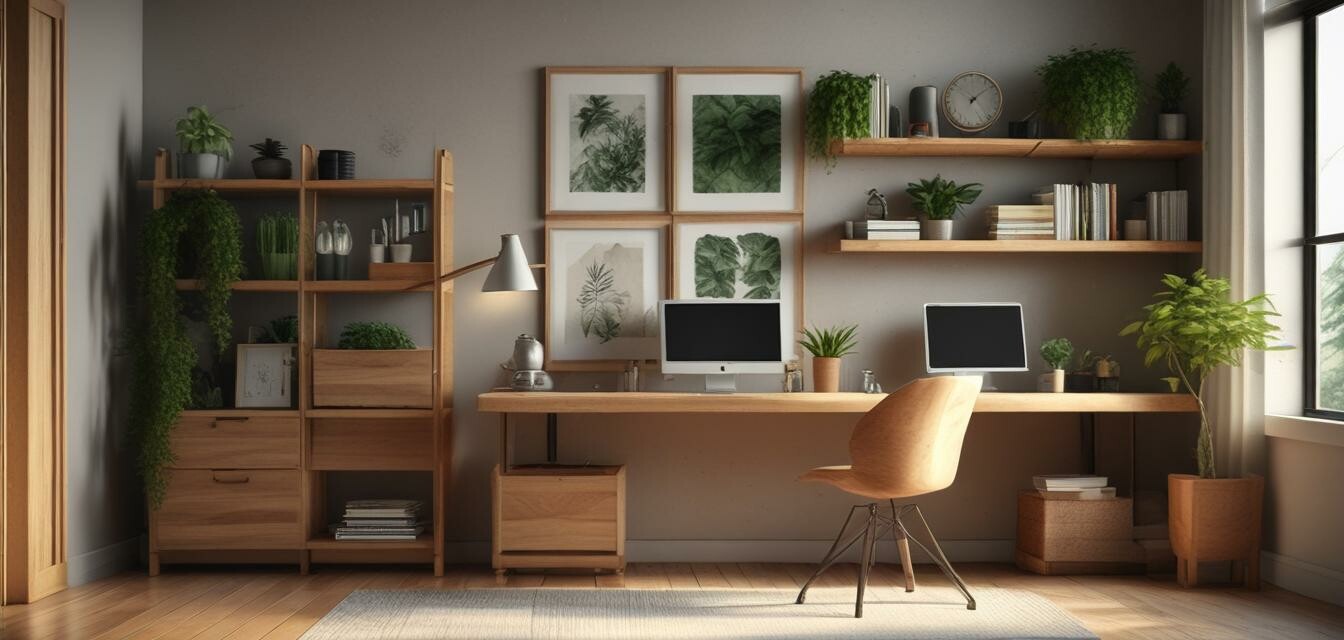
Eco-Friendly Trends in Home Office Design
- Natural wood brings warmth and sustainability to home office designs.
- Choosing eco-friendly finishes and materials reduces the environmental impact.
- Incorporating biophilic design elements promotes wellbeing and productivity.
- Smart organization tools enhance functionality while staying true to eco-friendly aesthetics.
- Furnishing your office with multi-functional pieces can increase efficiency and reduce waste.
The shift towards remote work has changed the way we view our home office spaces. With more people working from home, there is a growing trend towards creating eco-friendly and sustainable home offices. This article explores the current trends in eco-friendly home office design, emphasizing the importance of wooden furniture and sustainable practices.
The importance of sustainability in home office design
As concerns over climate change and environmental impact grow, making sustainable choices in our home office setup is essential. A well-designed eco-friendly workspace can improve productivity while minimizing one’s carbon footprint. Sustainable materials, like natural wood, support healthier indoor environments, making them a great choice for your home office.
Benefits of using natural wood
Natural wood is a popular choice in eco-friendly designs. Here’s why:
- Sustainable sourcing: Many wooden furniture pieces are made from sustainably harvested trees, ensuring that forests are preserved for future generations.
- Aesthetic appeal: The unique grains and colors of natural wood enhance the beauty of any office space.
- Durability: Wooden furniture tends to last longer than manufactured alternatives, reducing the need for replacements and waste.
- Biodegradable: At the end of their lifecycle, wood products are biodegradable, which is better for the planet compared to plastic or metal alternatives.
Current trends in eco-friendly home office design
Several trends have emerged in the world of eco-friendly home office design. From the types of materials used to the overall layout, here are some key aspects transforming the modern workspace:
1. Biophilic design integration
Incorporating natural elements into home office design, known as biophilic design, is becoming increasingly popular. This design philosophy emphasizes the connection between people and nature, contributing to enhanced well-being and productivity. Consider the following elements:
- Adding live plants to purify the air and create a calming atmosphere.
- Using natural lighting as much as possible and maintaining views of nature.
- Incorporating wooden accents and natural textiles to enhance warmth.
2. Minimalistic and functional furniture
Minimalism continues to trend in home office design, promoting a clutter-free workspace to improve focus. This often translates into functional furniture choices:
- Multi-functional desks that serve double duty as both workspaces and storage.
- Ergonomic chairs made from sustainable materials that support healthy posture.
- Wall-mounted shelves that save space while showcasing decorative wooden items.
3. Eco-friendly finishes and coatings
The choice of finishes for wooden furniture plays a crucial role in sustainability. Selecting eco-friendly paints, stains, or oils can significantly reduce harmful emissions and improve indoor air quality. Consider the following:
| Type of Finish | Pros | Cons |
|---|---|---|
| Water-based finishes | Low VOCs; quick drying | Less durable than oil-based |
| Natural oils | Enhances wood grain; non-toxic | Requires more frequent application |
| Eco-friendly paints | Variety of colors; lower environmental impact | May have limited availability |
4. Smart and organized spaces
Efficiency is key in a home office. Organizing the workspace with sustainable materials can enhance productivity:
- Use bamboo or reclaimed wood organizers to keep your desk clutter-free.
- Invest in eco-friendly storage solutions, like wicker baskets made from sustainable materials.
- Incorporate visible storage to limit the need for additional industrial materials.
5. Upcycling and repurposing
Upcycling furniture helps reduce waste while adding a unique touch to your home office. Consider repurposing items such as:
- Old wooden crates as bookshelves or document holders.
- Vintage wooden desks that can be restored to fit the aesthetic of your workspace.
- Unused wood from old projects for DIY décor items.
How to create an eco-friendly home office
Creating an eco-friendly home office starts with careful planning. Here are steps to integrate sustainability into your workspace:
- **Define your workspace:** Choose a dedicated space in your home that allows for privacy and focus.
- **Select natural wood furniture:** Invest in high-quality pieces that will last and add aesthetic appeal to your office.
- **Use energy-efficient appliances:** Consider using eco-friendly lighting and energy-efficient electronics.
- **Add plants:** Incorporate greenery for a refreshing and motivational atmosphere.
- **Declutter regularly:** Keep your workspace organized and remove any clutter to maintain focus.
Pros
- Enhances indoor air quality.
- Creates an inviting and comfortable workspace.
- Promotes sustainability and reduces environmental impact.
- Encourages productivity and creativity.
Cons
- May require a higher initial investment.
- Some eco-friendly materials may not be as durable.
- Limited color and finish options compared to synthetic materials.
Conclusion
As more individuals create home offices, embracing eco-friendly design principles has become essential. By incorporating sustainable practices and wooden furniture, you can create a workspace that is not only beautiful but also emphasizes environmental responsibility. For more trends and insights into sustainable practices, check out our Sustainable Practices category. Explore innovative ideas and keep up with evolving trends in home office design that prioritize both aesthetics and sustainability.